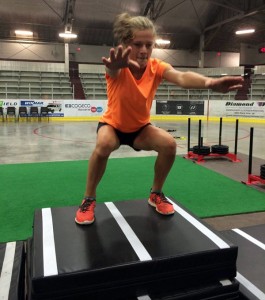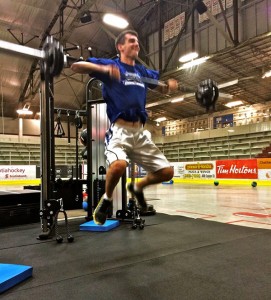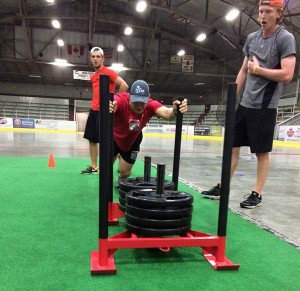Understanding Off-Season Training For Sports
The off-season is without a doubt the best opportunity to get stronger and faster that will translate to improved on-ice and performance in sport. A comprehensive off-season training program should include corrective work, strength & power, and a focus on energy systems. Many programs fail to deliver appropriate

Teaching the importance of landing mechanics and controlling eccentric dynamic hip stability are Phase 1 staples at Athletes Fuel.
My program is a progression of phases, with each phase having a primary goal and a secondary goal. In a sports setting such as ours, we are always concurrent and sometimes conjugate in respect to how we periodize and structure our training. We are concurrent in that we are training multiple qualities simultaneously. Yes we may have a primary goal and focus in each phase of program but we are also training other qualities as well, just limited in volume. However, we are also conjugated because our phases are linked together. Each preceding training phase is designed to enhance the following phase.

Phase 2 – 2014 Dr. Jack Parry ware winner Jake Lindley performing the Hang Snatch. This is an excellent way to close the gap between strength work and low-load power work.
Phase One – Work Capacity & Hypertrophy
Training here has a large emphasis on improving soft-tissue quality, correcting muscular imbalances, improving and restoring joint mobility at the joints that are built for mobility, and any necessary rehabilitation to injuries. We will also look to improve muscular hypertrophy, work capacity, and aerobic endurance capabilities. This ensures the player’s body has a strong foundation for Phase Two when we incorporate more intensive loads that focus on building strength and power. There is also a large educational and coaching component in teaching movement patterns and proper technique for exercises. Similarly, we outline our principles of high performance nutrition through a very in-depth and use-friendly nutrition manual. This helps provide our players with the knowledge and resources they need to make nutritional choices that will support improved performance.
Phase Two & Three – Max Strength & High-Load Power
These two phases are similar in that we focus on building strength, power and explosiveness. We begin to incorporate more alactic work such as sled pushes and linear speed drills. Our lift becomes more intensive in that our exercise selection becomes more progressive, and our rep range decreases while our load increases in

Phase 3 – 2014 OHL Draft pick Brady Pataki sled push marching. These are great for developing speed and power, and a quicker first step.
Phase Four – Power-Endurance & Energy Systems
As training camps and tryouts approach, we continue to build on our strength and power while also focusing on energy systems. This is the phase of training where off-ice conditioning and on-ice work becomes increasingly important. Players continue to translate their physical gains (size, strength, power) in off-ice training, but they should be devoting more time to on-ice skill development and conditioning. Our lifts change in that we do have some circuit-style training. This is almost the only time of year when we go through circuits. We build in appropriate exercise selection to help us maximize power-endurance, because that is what sport is all about; expressing many short bursts of explosive power in a fatigued state.
Remember, it’s not just the training that makes the difference. It’s all in the combination of proper training, performance nutrition, and recovery strategies. This is the type of format that will give players the best opportunity to maximize their gains in the off-season. They will be ready for training camp and most importantly, ready to perform throughout the ENTIRE season.
For more information on Athletes Fuels’ offseason training visit www.AthletesFuelFC.com



